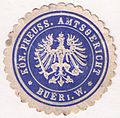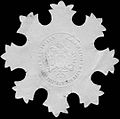Seal mark

A seal mark is an adhesive seal with which the authenticity and integrity of a shipment or a document is to be guaranteed.
use
Seal stamps were used from around 1850 to 1945 to seal envelopes and to identify written correspondence . They replaced the wax seals and sealing wax that had been in use until then . From around 1920 the use of seal marks gradually decreased. After 1933 they used only a few official agencies.
Seals are still occasionally used today to close important or confidential mail items. The packaging of commercial items is also often secured with seals to prove their original condition when they are handed over to the user.
The collecting of seal stamps is considered a branch of erinnophilia or a subsidiary area of philately . They are collected according to geographical criteria, subject areas or motifs.
Executions and issuers
Seal stamps were usually designed as rubberized, mostly round or oval adhesive seals made of paper and were issued by authorities, but also companies or private individuals. They were the size of postage stamps, a common measure, for example, was a diameter of 4 cm. In the Kingdom of Saxony there were rectangular seals.
Most of the time, the seals were not only printed in color, but also embossed to indicate a similar appearance to a wax or lacquer seal.
More recently, sealing marks (also in ribbon form: sealing tapes) have also been made from plastic films, the special adhesive of which ensures that the removal of the mark leads to visible damage or to the destruction of the mark.
Particularly secure seals have a hologram print and a unique consecutive number.
Official brands often have a coat of arms. Seals from private individuals were decorated with family crests or initials , for example . But there are also brands without pictorial representations that only have text inscription.
Seal of the Royal Prussian District Court Buer in Westphalia
Seal of the Magistrate of Elsterwerda
Seal of the mayor's office of Calvörde
Oval seal mark of the Grossenhain Office
Seal of the Telephon-Fabrik Actiengesellschaft Hannover , formerly J. Berliner
Postage stamps from Chile (state post)
Postage stamp from Chile ( Valparaíso Post Office )
Seal mark of a Saxon military court
Seal of the baronial administration of Loburg Castle with the Beverfoerde-Werries family coat of arms
Seal of the Wismar Engineering Academy
Postal seal stamps
The postal authorities had their own seals, so-called post seal stamps, which were used to seal damaged or opened mail. These stamps were used for mail that was opened to the post office or damaged in transit or had to be opened by the postal service due to undeliverability and then closed again.
Today the postal seal is replaced by an outer packaging. At Deutsche Post , for example , items damaged during shipping are packed in an additional plastic sleeve before they are delivered.
Funeral stamps
Mourning stamps were issued on mourning occasions, especially when a monarch died during the state mourning that followed. These were usually regular stamps of the respective authorities, which were overprinted with black ink.
literature
- W. Grallert: Lexicon of Philately. 2nd Edition. Phil * Creativ GmbH, Schwalmtal 2007, ISBN 978-3-932198-38-0 , p. 367.
- Large lexicon of philately . Bertelsmann Lexikon Verlag, Gütersloh 1973, ISBN 3-570-03229-9 , p. 432.
- Gerhard Rungs: Post seals. In: Post and telecommunications history between the North Sea and the Baltic Sea , issue 1/1979, pp. 73–94
Web links
See also
Individual evidence
- ^ History of the seal marks , accessed on January 24, 2010
- ↑ a b c d Christa Pieske, Konrad Vanja u. a .: The ABC of luxury paper. Catalog for the exhibition of the Museum für Deutsche Volkskunde Berlin. Staatliche Museen Preußischer Kulturbesitz, Berlin 1983, pages 243–245.
- ↑ Section 54 (5) of the Joint Rules of Procedure for the Berlin Administration, General Part (GGO I) i. d. F. dated October 18, 2011. Seal marks are still used in Berlin, for example, when sorted packages of voting papers are transported to the responsible district electoral office after they have been counted by election workers.












